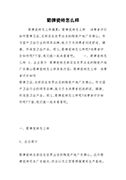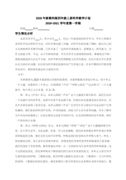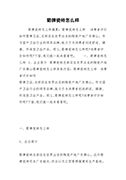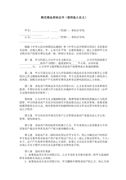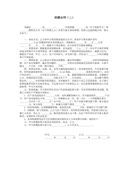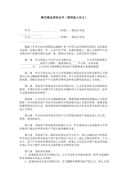《牛津小学英语》1B Unit 3 Colours(精选17篇)一年级英语教案
《牛津小学英语》1B Unit 3 Colours(精选17篇)
《牛津小学英语》1B Unit 3 Colours 篇1
一、教学内容:《牛津小学英语》1blet’s learnlet’s play
二、教学目标:
1、能听懂、会说、认读以下八个有关颜色的单词: red、blue、yellow、green、pink、purple、brown、orange;
2、能用what colour is it? it is…进行问答。
三、教学重点:八个有关颜色的单词
四、课前准备:
1、师:水彩笔、彩色卡纸、彩色气球、磁带;
2、生:水彩笔、纸。
五、教学过程:
1、warming-up
(1)sing a song;
(2)greeting with everyone;
(3)ask some question, call some student answer it。
2、presentatio
(1)show a red colour chalk to students
t: what colour is it?
s: red.
t: yes, it’s red (write the word on the blackboard) follow me [red](repeat three times)
(学生在幼儿园时对有些颜色单词有过初步的认识,所以可试着通过学生的口引出单词,如果不知道则由教师引出,以下几个颜色单词的教授也如此)
(teach the word “blue” in the same way)
(2)ask a student on the yellow clothes
t: what colour is it?
s: yellow
t: right! it’s yellow (write the word on the blackboard) follow me [yeleu](s repeat it, say it one by one)
t: look, chen wear a green clothes. (write the word on the blackboard) follow me (s repeat it, say it group by group)
(3)show students a pink balloon
t: what colour is it?
s: it’s pink.
t: good! it is pink (write the word on the blackboard) follow me (s repeat it, say it one by one)
(teach the word “purple” in the same way)
(4)show student a brown colour card
t: what colour is it?
s: it is brown.
t: yes, it is brown. (write the word on the blackboard) follow me (s repeat it, say it with other words)
(teach the word “purple” in the same way)
3、practice
(1)listen to the tape and read after the tape while look at the word;
(2)work in group of 4:one say a colour, the other three point at the right colour card as quickly as possible;
(3)play a game : guess what colour it is?
t: (hide a colour card, then say) what colour is it? guess!
s: it is red
t: no, it is green./ yes, you are right.
4、consolidation
(1)put all the colour cards together , then ask the students say them out one after another;
(2)look at the words and read them out;
(3)do what teacher say: teacher say a colour ,all students draw the right colour on the paper, then show it。
5、homework
(1)do the workbook ;
(2)say out the colours in your bedroom, then tell them to your parents。
六、教学反思
1、采用歌曲、师生交谈的方式开始一堂课是激发学生兴趣,活跃课堂气氛的有效途径;
2、采用通过粉笔、学生穿着的衣服、气球、有色卡片等多种教学手段创设情景引出新知识,能够有效地吸引学生的注意力,使新授的过程不至于太呆板;
3、运用游戏巩固新知识是本节课的特点,取得了良好的教学效果;
4、由于学生人数较多,教学中操练速度与密度要把握好一个度,做到点面结合。
《牛津小学英语》1b unit 3 colours 来自98e范文网。
《牛津小学英语》1B Unit 3 Colours 篇2
教学内容:e. look, read and judge.补充练习a部分
教学目标:
1.能听懂、会说、认读单词centimeters。
2.通过观察、朗读、训练学生阅读理解语篇的能力,并能针对问题做出正确判断。
3.通过听力练习,提高学生观察思维及听的能力。
教学重点:能正确流利朗读阅读材料,并理解内容。
教学难点:
1.流利、规范朗读语言材料
2.正确完成听力
教具准备:录音机、磁带、图片、词卡等
step 1 warm up
1. greetings
2. sing a song: i wish i was taller!
3. free talk
利用室内现有物品及学生实际情况,围绕b.c部分的词.句及…as…as…句型与学生间灵活展开对话,以此检查学生对知识掌握情况:
step 2 revision
1. listen repeat and answer(a部分内容)
①on sunday morning. where did su hai go for a walk?
②who did she meat?
③what did they do under a big tree?
④do su yang and su hai look the same?
⑤is su hai as tall as su yang?
⑥who’s younger, su hai or su yang?
⑦does jack have any brothers or sisters?
⑧how old and is jack?
2. look and read
出示b部分图片比较,生说形容词及其比较级。
3.写出形容词的比较级
step 3 presentation
1.导读e部分引言部分,学习goal keeper。
2.生自由朗读。
3.学习165 centimeters。
出示指导朗读,并适当拓展。
4.指生读
5.指导生完成下面的判断
6.read and check
step 4 do exercise(练习册a部分)
1. look at the pictures and talk about them.(可让生同位间进行)
2.listen to the tape.(指导生记录关键词语)
3.listen and repeat.
4. listen and judge.
5. listen and check.
step 5 home work
1. read the text of part a.
2. read and write the words two times.(b部分)
板书内容:
词组:b部分的形容词及其比较级goalkeeper, centimeter
句型:…as…as…
…(比较级)than…
板书设计:
教后笔记:
《牛津小学英语》1B Unit 3 Colours 篇3
教学内容《牛津小学英语》3b unit 1 b look and learn教学目标1.ss can understand and read these eight words: a school bag, a crayon, a storybook, a copybook, a tape, a stapler, a toy train, a knife.2. ss can understand and say the new sentences “what’s this/that?” and can use “it’s…” answer.教学重点难点1.pronunciation of the eight words.2.expression: the new sentences “what’s this/that?” and can use “it’s…” answer.教学准备tape and tape player. cards of new words.教学环节过程目标教师活动学生活动 free talk presentation practice home work greeting and motivation. ss can under- stand and read these eight words: a school bag, a crayon, a storybook, a copybook, a tape, a stapler, a toy train, a knife..2.ss can under- stand and say the new sentences “what’s this/that?” and can use “it’s…” answer. use game to help studentspractice the eight new words and the new sentence pattern. organize:good morning, class.hi.hello.what’s your name?what’s your name?a this is b. (1) teaching the new words:(show a new word card to students.)school bag. (show students a card of new words.)crayon.(show the card of new words to students.)storybook.(show students a card of new words.)copybook.read these cards.(use the same way to teach the other four new words),read these cards one by one.(2) teaching the sentence:(show the card of crayon).what’s this? (ask self).it’s a crayon.(show the card of tape).what’s that? (ask students).(use body language and countenance to help students understand). let’s play a game.let’s guess.(show the back of the cards to students).no, it isn’t.yes, it is.what’s this/that? 1. repeat picture 1&2 of part a.2. read new words of this unit. good morning, miss.hi.hello.i’m a.i’m b.a: nice to meet you b.b: nice to meet you, too school bag. (read one by one). crayon.(read one by one). storybook. (read one by one). copybook. (read one by one).school bag, crayon, storybook, copybook school bag, crayon, storybook, copybook…. (look at teacher and try to understand). it’s a tape. ok.tape?knife? it’s a …
《牛津小学英语》1B Unit 3 Colours 篇4
教学内容:
1、b部分单词:a postcard, glue, writing paper, an envelope, write a letter。
2、c部分第1、3、5幅图。
教学目标:
1、能听懂、会说和会读单词和词组a postcard, writing paper, an envelope。
2、能正确地听、说、读、写单词glue, write a letter。
3、能正确地听、说、读、写句型can i have…? what for? i want to…
教学重点:
1、能熟练地听、说、读、写单词glue, write a letter。
2、能正确地听、说、读、写句型can i have…? what for? i want to…。
教学难点:了解glue和writing paper是不可数名词。
教具准备:教师和学生都准备明信片、邮票、信封、胶水、信纸的实物,c部分挂图、图片。
教学过程:
step 1 warm up
1、 sing a song: will you join me?
2、 free talk(以将要做什么为谈话主题)
①师生交谈
t: what are you going to do this weekend/this morning/ this eneving/tomorrow afternoon?
s: i’m going to…
s: i’m going to…
…
②小组互相交谈
what are we going to do this morning/ this weekend/ tomorrow evening…?
where are we going to do this afternoon/ tomorrow morning?
step 2 presentation
1、 teach: a postcard
①t: today is my birthday, i received a postcard from my brother. do you know“a postcard”?
②教师出示明信片,领读a postcard。
③教师出示以前学过的单词a postman和a card,告诉学生a postcard是个合成词。
④师生齐读post, post, card, card→postcard。
⑤两个学生开火车操练a postcard, a postcard, i have a postcard。
⑥教师走到台下,问一位学生: can i have a postcard?引导学生回答sure. here you are。教师接着说i want to write to my brother jim。
⑦教师出示几张明信片,示意学生用句型can i have a postcard?提问,教师相机说what for?
⑧教师大体介绍what for的意思,告诉学生what for相当于why。
⑨师生,生生操练。
can i have a postcard? what for?
i want to write to my sister/ my father/ john… sure. here you are.
2、 teach: writing paper.
①t: i have some writing paper.教师告诉学生:writing paper性质等同于以前所学的newspaper,是不可数名词,两张信纸可以说two pieces of paper,一些信纸叫some writing paper。
②chant: writing, writing, writing, writing, paper, i have some writing paper.
③教师走到台下,与个别学生操练can i have some writing paper?引导学生说what for?
④t: i want to write a letter.
ss: sure. here you are.
⑤师生交换角色,话题为学生向老师索要信纸。
3、 teach: write a letter
①t:在三年级学字母时,letter解释为字母,而在这里,letter则解释为信,write a letter解释为写信。
②教师范读letter, letter, write a letter。
③学生齐读letter, letter, write a letter。
④play a game:绕口令
write, write, write a letter,
letter, letter, write a letter,
let’s, let’s, let’s write.
⑤拼读letter。letter, letter, l-e-t-t-e-r, letter, letter。
⑥拼读write a letter。
4、 teach: an envelope
①t: yesterday evening, i wrote a letter to my teacher. now, i need an envelope.教师边将信塞进信封。
②教师范读an envelope, 从不同方位给学生示范,采用分音节教学法,enve-lope→envelope。
③男、女生分角色读an envelope, an envelope, i have an envelope。
④四人开火车读an envelope, an envelope, i have an envelope。
⑤扩词练习。
for example: an envelope, an envelope, a red/ yellow/ white/ nice envelope, an orange/ old envelope。
5、teach: glue
①教师拿起刚才塞进信封的那封信,发现封口还没有贴好,相机说:look, it’s open, can i have some glue?顺势引导学生说sure. here you are。
②glue属不可数名数。
③教师范读。
/u:/ /u:/ glue
glue, glue, glue, some some glue
④学生模仿读。
⑤开火车拼读:glue, glue, g-l-u-e→glue, glue.
step 3 look and say
1、出示c部分第一幅图,让学生仔细看图,理解图意,运用句型can i have a/ an/ some…? what for? i want to… sure…here you are.对话。
2、出示第三、五幅图,同桌两人运用以上句型进行对话。
3、指名两至五组表演。
4、这部分为四会内容,教师有必要范写一幅图,其余三幅图请学生参照板书,当堂完成。其中要向学生特别强调i want to+动词原形。
5、学生书写,教师巡视。
step 4 consolidation
1、listen to the tape, then repeat.
先合上书本听一遍,再打开书用手指着跟读。
2、listen and point.
此游戏先由教师说单词,请两位学生比赛看哪一位指着又快又准,获胜者留在台前,顶替老师的角色,继续进行游戏。
3、a guessing game.
可将本部分词汇设计为谜语,如:liu tao’s mother is now in guangzhou, liu tao is in naijing. he wants to speak to mother. i can help them. what am i?
step 5 homework
1、听b部分所学单词各五遍,跟读五遍,预习剩余单词,听五遍。
2、抄写glue, write a letter各五遍。
3、说c部分第一、三、五幅图各两遍,选择两幅图写下来。
4、继续完成编谜语的作业,下节课在free talk中与大家交流。
板书内容:
1、课题:unit 7 a letter to a penfriend
2、单词:write a letter, some glue.
3、句型:can i have…? what for?
i want to… sure, here you are.
板书设计:
《牛津小学英语》1B Unit 3 Colours 篇5
备课、反思案例《牛津小学英语》3a unit5 how are you?(第一课时) 常州市西林实验学校 张彩琪一、content and purpose1、 phrases: not bad, not so good.2、 sentences: a: how are you? b1:fine,thank you.and you? a:i’m fine ,too. b2:i’m fine,thank you. b3:not bad.b4:not so good. a::i’m sorry.二、teaching steps:step1: warm up(1) sing a song “hello,i’m helen”(2) let’s speak english.(3) show some pictures to students.<chant>(4) please “talk about the pictures”with “this is a……”ask and answer: good afternoon ,. good afternoon,……can you introduce a new friend to your partener.,this is ○○,○○,this is.nice to meet you○○,nice to meet you,too.sit down,please.thank you.some apples,please.thank you.(5) can you introduce angel(teacher’s name)to your deskmate.——hello,nary.——hello,david.this is angel.angel,this is david.——nice too meet you david.——nice too neet you,angel.sit down,please.——thank you.——some apples,please.——(taste it)how nice!(引出how)操练how.step 2: new lesson:how are you?(t)t: how are you?s1: yes.s2: ok. 〈出现错误〉t: please ask me “how are you ?”.s1: how are you?t: fine.(肢体语言“身体棒”)(1)s : how are you.t: fine, thank you.(2)chant: how,how,how are you?fine,thank you.(3)s—s: ask and answer: , how are you? fine, thank you.c、出示简笔画。act the picture.s:how are you?t:i’m fine.i’m not bad.板书,引出。not bad.(1) practice(2) ask and answer (picture).d、a boy in our class is ill.t:how are you, ma dejing?are you ok?s:no.t:sorry,you’re not so good.. you should have a good rest.(安抚)practice: (1) not so good.(2)ask and answer: “how are you? not so good. .i’m sorry.”step3: consolidation:1、 let’s sing a song“hello, hello, how are you?”2、 show some pictures and talk about them.3、 let’s make a new dialogue.4、 listen and judge.step 4:sing a song“goodbye”and finish the class. 让英语教学回归自然――牛津小学英语3a unit5课后反思 朋友中经常会有人这样问我:假如让你重新选择,你做什么?很少人想做现在的自己。同行们,如果让你重新选择呢?你是否还会选择做教师呢?那么,如果让我重新选择,我想我还会选择做一个教师。午饭时,校长说是市教研室胡澄宜老师来听我的课,要我认真作准备,平时见惯胡老师随和风趣,豪爽大度的面,我心中更自信,只有在自然的状态下轻松走进课堂,才能上出自己满意的高水平的课。第一节课是体育课,我躲在多媒体教室作准备。几个调皮的男生玩累了,从窗口看见我,奶声奶气地说,“angel,我们到处找你不到,原来angel躲在这里呀!孩子们愉快的笑声把我头脑中原本崩紧的神经缓缓放松了。孩子,你就是老师快乐、成功的源泉呀!我在黑板上认真地板书,优美的英文字母不仅耐看,也让我们师生共同朝美的目标迈进。它拉近了我们的距离,要叫学生做得好,首先我自己要做到最好。这就是我的准则。1、我们在歌声“i’m hello,hello,hello”中开始了这堂课。轻快的音乐让孩子们马上进入了英语语言的氛围中,争着上台表演。象往常的课一样,歌词被我改成i’m nancy, hello,hello. i’m lily. hello,hello.2、接下来是复习环节,我出示了常规的实物与图片:what’s this ? this is a……的句子带动复习词汇。如:monkey,monkey,this is a monkey.令我吃惊的是今天.学生的表现远远超出我的想象,除了部分较优秀的同学,普通的同学也展示出了他们鲜为人知的一面。三年级的学生才学了几个单元,他们居然把学过的对话,老师平时使用的课堂用语都用上去了,编了一些与动物对话的chant。dog, dog. may i come in?cat, cat. let’s play a game,bird,bird. sit down,please.难怪连胡澄宜老师都感叹,“我今天是第一次看到学生这样创造性地编与动物交流的chant这种复习单词的手法,新颖独特,既巩固了单词,运用了课堂交际用语,更体现出人与人之间的交流沟通,人与动物,人与自然的一种和谐共处的关系,学生的创新能力也很强。3、由词汇的复习循序渐进进入词组,句子,对话的训练。由已学过的生活场景的对话表演引入到本课交际用语how are you? fine, thank you. not bad, and you? not so good. i’m sorry. 学生们在自然生活的情境中自由地交流,合作地学习,愉快地表演。最让我感动的是我们班的马德金同学从中午开始人就不舒服,我打电话到他家没有接,无奈之下,我只能叫他多喝开水在办公室休息,但这个倔小子坚持要来上课。在我担忧他身体的同时,这个学生不爽也成了我教学的契机。为我的课堂提供了一个很好的生成资源。madejing is not so good.我很快就将这个句型紧贴着这个生活实例输送给我的孩子们。听课老师也不禁为我叫好。4、这堂课我们师生一共唱了3首歌,每首歌并不仅为了烘托气氛,它在活跃学生思维的同时将教学内容与紧紧融为一体。如hello,i’m helen.是复习旧的交际语言而用。而我将hello,how are you?提前教学也正好与今天这堂课的新授内容相吻合,在课堂结束之时,“goodbye”拉近了我们师生的距离,这让我想起商场结束营业时所放音乐“归家”的温馨。40分钟很快就这样过去了,课堂已经成为我们交流的舞台,我们在这舞台上共同努力,共同分享成功的喜悦。胡澄宜老师说:乡镇也能出这么好的教师,你们的教师水平并不低于市中心小学的教师,你们完全应该到更高的舞台上展示自己。这些话语让我们这些城市边缘的老师们信心百倍。教学的成功让我激动,激动的同时又引发了我的几许感慨与反思:就象今天课堂上chant的创造性的使用,是在胡澄宜老师编写chant形式儿歌的倡导下的有效应用,胡澄宜老师给我们搭建了英语教学的平台,理论的基础,我们在此基础上根据教学内容对chant进行了再创造,以满足课堂教学的需求,最终成为了我们教师自身教学成果的积累。其实在日常,有些好的教学策略,教学方法在课堂上灵光闪现,我们捕捉它们,成功使用只是一种短暂行为,激动之余它就随时间悄悄地溜走了,象一颗流星,或许我们以后很难再捕捉到它的影子。为什么?因为我们缺乏理论的高度来提炼这些现象。胡澄宜老师这次对我这堂课的优点、缺点,都做了点评。给予我很多鼓励和启发。让我坚信不疑,我们的英语教学贴近生活,它已融入了自然,它绝对有生命力,它必将成长为一棵枝繁叶茂的参天大树。
《牛津小学英语》1B Unit 3 Colours 篇6
unit 4 review and check
连云港市赣榆县青口中心小学 肖淑芳
单元教材分析:
本单元是复习单元,着重归纳了第一单元至第三单元的主要语言项目,通过看图编号,说说讲讲,完成句子等练习,帮助学生复习巩固以学的词汇,句型和日常交际用语,使学生的听、说、读、写能力在原有的基础上有所提高。在教学时,教师要分析学生的学习现状,课堂上根据学生的掌握情况,尽量采用图片,实物,多媒体等直观教具,结合游戏,情景对话等形式,对基础知识和基本技能进行训练,从而提高学生灵活运用语言的能力。
教学要求:
1 通过复习,使学生熟练的掌握四会单词,词组和句型。
2 通过本单元的复习操练,要求学生能综合运用所学的日常交际用语。
教学重点:
1 掌握一至三单元的四会单词,词组及句型。
2 掌握一至三单元的日常交际用语,并在实际生活中熟练运用。
教学难点:
1 能根据情景正确的使用形容词和副词的比较级。
2 能会用英语问路。
教具准备:
录音机、磁带、图片及相关实物。
课时安排 : 共四课时。
第一课时:复习1,2单元,完成a部分的练习。
第二课时:完成b,d部分的练习。
第三课时;复习第三单元,完成c部分。
第四课时:综合复习,完成练习册。
友情提示:
1、教师要帮助学生归纳形容词和副词比较级的构成及用法,帮助学生巩固记忆,达到熟练掌握,准确应用的目的。
2、对于“问路”这一语言项目,教师要多结合学生的生活实际进行交际操练,学以致用的目的。
《牛津小学英语》6b unit 4 单元教材分析 来自98e范文网。
《牛津小学英语》1B Unit 3 Colours 篇7
教学内容:《牛津小学英语》6b unit 3 asking the way b look, read and learn及c look and say。
教学目标:
1. 能正确地听、说、读、写词汇turn left / right, post office, get on, get off, along, street。
2. 能正确地听、说、读词汇shopping, centre, middle school, primary school, train station, history museum crossing。
3. 能正确地听、说、读、写句子can you tell me the way to…, please?
4. 能听懂、会说句型和日常交际用语go along this street,and then turn…at the …crossing.
教学重点:
1. 能正确地听、说、读、写词汇turn left / right, post office, get on, get off, along, street.
2. 能正确地听、读、写句子can you tell me the way to…, please?
教学难点:
1. 能正确地听、说、读写本单元的四会单词和句型。
2. 能运用c部分的句型进行问路的情景对话。
教具准备:本单元的挂图、单词卡、磁带、录音机、场所类卡片及一张城市交通图。
教学过程:
step 1 warm up
1. sing a song:do some exercise with me.
热身运动,师生跟音乐边唱边跳,同时复习turn left和turn right,为后面的教学做好铺垫。
2. listen and do.
show me your right hand / touch your left ear / stand up / turn left / turn right…
step2 presentation and practice
1. 师生对话引入本课话题。
t:liu jing is new here. she comes from fu jian. she wants to buy some books. but she doesn’t know the way to the bookshop. can you help her?
s:sure.
t:good. look at the map of the city.(出示本地区的地图)where’s the bookshop?(教师指着地图,引导学生找到书店的位置并导入新授知识)。
2. 利用地图,师生交流学习句型。
a:excuse me,can you tell me the way to the bookshop?
b:let me see. er,…go along this street, and then turn left at the second crossing. the bookshop is there.
①板书对话内容。
②对板书中出现的生词along, street, turn right / left等进行拼读教学,并让学生理解。
③chant:where’s the bookshop?
bookshop, bookshop, where’s the bookshop?
can you tell me the way to the bookshop?
go, go, go, go along this street, then turn left.
you can see the bookshop at the second crossing.
3. 创设情景,用c部分的句型逐一引出b部分单词。
t:andy is yang ling’s friend. he wants to visit some places. this is his timetable. where will he go? let’s try to tell him how to get there. ok?
①用图表展示andy想去的地方。
time(时间)places(地点)pictures(图片示意)mondayhistory museum配相应的图片(下同)tuesdaypost officewednesdayno.1 primary school thursdayno.4 middle school fridaypost office saturdayshopping centre sundaytrain station
②引导学生学习b部分单词,多音节词可分音节进行教学,出示音标,降低读音难度。
③学生听录音,模仿跟读单词。
④利用look and say的方法引导学生复习b部分的词汇。教师可快速闪动单词图片,让学生用英语说出人物所做的动作或所看到的不同场景。
⑤游戏“开汽车去某处”,在玩的过程中强化记忆get on / get off.
⑥利用简单的路线图配上表示不同场所的图片,运用刚才所学句型进行师生交流,生生交流。
⑦小组内操练对话。
step3 consolidation
1. 教师出示c部分的图片创设情景引出句型的操练。
t:先介绍图片,the park is on your left. 让学生模仿说出其他的地点。
t:can you tell me the way to…, please?
这样学生就很容易回答了,用同样的方法操练其他的地点(shopping centre, bus station, wc…)。
2. 利用情景图,师生示范对话,让学生模仿练习。
3. 让掌握较好的学生做示范,然后同桌问答。
4. 教师板书四会句型,由学生集体朗读。
5. 书写指导。
6. chant:where’s the bookshop?
step4 homework
1. 朗读并抄写要求四会掌握的单词和句子。
2. c部分自选两幅图编对话。
3. 用英语介绍自己所在地区的一处景点(或场所),描述其具体方位。
板书内容:unit3 asking the way
①词汇:turn left / right, post office, get on / off, along, street, shopping centre, middle school, primary school, train station, history museum, crossing。
②句型:can you tell me the way to…, please? go along this street,and then turn left / right at the … crossing. the …is on your… that’s all right.
板书设计:
《牛津小学英语》1B Unit 3 Colours 篇8
一、教学目标1. 能听懂、会说、会读和会写句型what are these/those? they’re ….how many kilos? …kilos, please.2. 能听懂、会说、会读和会写单词grapes.二、教具准备1、课前在教室四周贴上水果图片,将全班分成6个小组。2、超市小货架,营业员佩带的胸卡、单词、句型卡片、喇叭、帽子、各种水果实物。三、设计思路围绕“听说读写能力的培养”这一主题,通过深入浅出的句型操练,让学生在掌握句型的基础上主动参与购物、自主训练,最终达到把所学知识转化为实际应用能力的目的。三、教学过程step 1 say a rhyme《they are all play》 pears, bananas and pineapple. oranges, peaches and apples. big fruit and small fruit, they are all very good.(设计意图:通过复习三年级学过的一首小诗,充分调动学生的情感因素,变被动为主动,激发学生的学习兴趣。巩固再认各种水果,为呈现任务做好准备。)step 2 presentation(一)teach: what are these/those? they’re ….1. t: boys and girls, now i’ll play a game with you “touch and guess”. look, here’s a big bag. who can come here and touch? (一生上前来摸一下)t: what’s this?s: it’s an apple.t(面向全班):yes, it’s an apple.t: go on .(s继续摸)t:what’s this?s: it’s an apple, too.t: it’s an apple, it’s an apple, too. they’re apples.t 出示卡片they’re ….ss read together.(设计意图:从触摸游戏入手,激起学生的好奇心和积极参与的欲望,同时将学生的注意力集中到水果复数上,引出句型they’re …,同时达到句型what are these?早渗透、勤反复的目的。)2.(出示单词图片)t:what are these? 引导学生回答they’re ….(apples、oranges、pears、bananas、peaches) t 最后出示grapes, 学习葡萄,学生拼读练习。 (拿着葡萄问学生)t:what are these? s: they’re grapes. practice in chains. (学生进行连锁操练what are these? they’re grapes.) t出示句型卡片:what are these? 拼读单词these, 读整个句子。 s拿出自己带的水果进行同桌操练。 check: s1: hello, , what are these? s2: they’re …. s3: hello, , what are these? s4: they’re …. ……(设计意图:用已经学过的水果图片操练句型what are these? they’re…,引出本课新单词葡萄。这样既复习水果单词,又可以让生词、句型结合起来学习。)3. t: now, let’s play a guessing game. i put some fruit over there. can you guess what are those?(手指墙角桌上用布盖好的水果) s: they’re …. 若学生回答不出来,继续问2遍后揭示答案。 t 手指教室四周墙上的水果图片问:what are those? ss answer t 出示句型卡片:what are those? ss 拼读单词those, 读句子。 pair work: what are those? they’re …. check(设计意图:以猜的游戏入手,抓住学生的兴奋点,引出句型 what are those?)4.t: now, let’s play. boys and girls, stand up, please. follw me.t: this, that, these, those.(边说边做手势)ss 站起来跟着做。t:now, listen and do.老师说单词,学生做手势。t: let’s say a rhyme: this this this,that that that,these these these,those those those.5. t: what are these/those? ss: they’re…. t: they are fruit. do you like fruit? ss: yes, i do.(设计意图:在学完两组句型之后,学生应该得到一点放松,因此接着设计一个简单的rhyme,既复习巩固了知识,又活跃了气氛,使学生全身心放松,缓和了紧张的学习气氛。)(二)teach: how many kilos?…kilos, please.1. t: now, let’s go to the supermarket. ok? close your eyes.老师戴上帽子,将贷架摆上桌,戴上售货员的牌子,拿出一只喇叭,扮演水果店老板叫卖:apples, apples, three yuan a kilo; bananas, bananas, four yuan a kilo。(设计意图:创设购物情境,教师将平时的水果店缩小了放进课堂,扮演水果店老板叫卖,同时将卡片3元/公斤three yuan a kilo、4元/公斤four yuan a kilo出示,使学生对kilo有一个初步的印象,为进一步教学kilo打下基础。)2.t 出示卡片:1公斤:one kilo 学生练说1公斤、2公斤、3公斤、4公斤 t(出示1公斤、2公斤):one kilo and two kilos, how many kilos? ss answer. 反复练习几次。(设计意图:用简单的数学加法引出how many kilos?…kilos.学生容易理解接受。)3.t出示句型卡片how many kilos?…kilos ss 读这一句子。 t 出示5公斤、6公斤、8公斤,进行学生之间的ask and answer。 t 拿出小型水果筐(装上水电,贴上重量。)进行小组与小组之间的ask and answer.4.t: now ,boys and girls, you can come here and do some shopping. can i help you?s1 come to the front: i’d like some …,please.t: how many kilos?s1: … kilos, please.t: here you are. (老师与学生之间练习两次。i’d like some …,please.三年级已经学过,若学生一时忘了怎么说将这一句型出示一下。)t: now , who will be a saler?s3: i try.s3: can i help you?t: i’d like some …, please.s3: how many kilos?t: four kilos, please.学生与师对话两次。5. t: now you can buy some fruit from your saler. let’s have a competition.(将学生分成6组,每组一个售货员,其他同学扮演顾客向售货员买水果。每个售货员手里有十几张水果的图片,获知所购重量后,直接写在图片上,卖给顾客。最后比较哪一组的售货员卖出的水果多。)6.t: let me see. group 1 , group 2, group 3, group 4, group 5, group 6.评出优
《牛津小学英语》1B Unit 3 Colours 篇9
一、教学理念
《英语课程标准》提出“学生的发展是英语课程的出发点和归宿”。 因此在本堂课的教学设计中,我充分围绕“学生是英语学习的主人”这一主题,让学生在情境中积极主动地探究语言知识,培养了他们高度的参与意识,提高了他们的学习积极性,让他们通过活动获得知识,形成能力。
根据这一主题,我将这一堂课定位于“活动”这一主要形式上,从以下几方面着手,进行了教学设计:
1、注重学生学习兴趣的激发。
学习是学生的自主行为。我们的教学更重要的是唤醒和激发学生主动参与学习的意识,使学生产生学习需求,因为兴趣是儿童认知活动的动力,最好的学习是学生对所学有内在兴趣。在本堂课中,我从学生所喜爱的游戏、比赛及身边的事物和情境入手,充分调动他们的积极性,激发他们的内驱力,变“要我学”为“我要学”,由被动地学转为主动地学。真正体现了教学的艺术不在于传授本领,而在于激励、唤醒、鼓舞。
2、营造和谐的课堂氛围。
现代教学论认为,民主、和谐、宽松的课堂教学氛围是学生自主学习、主动发展的关键所在。因此,在本堂课中,我采用了合作学习的方法,充分体现了师生间的民主合作性,课堂上师生合作、生生合作,平等讨论、相互补充的气氛极浓。给学生提供充分展示自己的机会,张扬自己的个性。学生无拘无束、轻松愉快地用英语表达自己的见解,在实践中学习语言,在想象中发展思维,在交流中提高能力。
3、让学生获得成功的喜悦。
苏霍姆林斯基说:“成功的欢乐是一种巨大的情绪力量,它可以促进儿童好好学习的愿望。请你注意无论如何不要使这种内在力量消失,缺少这种力量,教育上的任何巧妙措施都是无济于事的”要想促进学生主动发展,在教学过程中就要创设使学生能够获得成功的条件和情境,才能有效地培养学生的自信心,才能激发学生的学习主动性。在本课的教学中,我让学生自己用所学自编小诗、表演对话,不仅把学习的主动权交给学生,而且放手让学生自主学习实践。学生通过讨论探究,交流实践,获取了知识,发展了能力,获得了成功的喜悦。
4、在大胆设想中培养学生的综合能力。
德国诗人海涅有句名言:“思想走在行动之前,就如闪电走在雷鸣之前一样。”只有观念先行,才能产生与时代相适应的教学思想和教育模式。
在本课教学中,我充分贯彻新课程理念,运用了任务教学法,并把它与情景教学法、交际法和多媒体很好地结合,落实到各项活动中。学生通过自己体验,探索学习语言,又通过各种活动来操练语言知识,自己动手、动脑、动口、动眼、动耳,提高了综合语言运用能力,发展了思维。
总之,在设计本课的教学时,我觉得不仅要加深了学生对语言知识的理解,更要转变学生学习的方式,让学生放松身心,敢思、敢想、敢说、敢写;发展他们的思维,这样才能让他们荡起快乐的心灵之舟,在英语学习这片蔚蓝的大海上扬帆远航。
二、教学详案
1、教学目标:
1)知识与技能目标:
a、能听懂、说出词汇 open, close, eat, drink, draw, read, write, copy。
b、能听懂、并用祈使句及其否定句"don't ... ..., please"。
2)运用能力目标:
能用句型"don't ... ..., please"请他人干某事和不要干某事。
3)素质教育(文化、情感态度、策略)目标:
a、通过本堂课的教学,让学生明白在某些场合能干某事和不能干某事。
b、进行必要的文明礼貌教育。
2、教学重点:
1)词汇:open, close, eat, drink, draw, read, write, copy。
2)句型:"don't ... ..., please"。
3、教学难点:
词汇和句型的发音,让学生注意发音到位。
4、课前准备:
1)多媒体课件。
2)学生带一些食品饮料类的实物,教师带好奖品、盒子等物品。
3)将学生按合作小组的座位排列。
5、板书设计:
unit 8 in class nov. 25
don't ... all right.
... , please.
draw an apple apple
6、教学步骤:
warm up
1) chant: please stand up.
2) sing an english song: go to school
(全班进行热身活动,使学生在一开始就情绪高涨,调动他们的热情,提高学生的积极性和学习兴趣,并沟通了师生之间的感情。)
greetings
1)教师和全班同学打招呼。
2)教师和个别学生用以下句型交流:what's your name? your name,
please. what's this/that in english? where is it? is this/that your ...?
(因为在本课中将会带到一些实物的名称和有关地点的介词短语, 在这里既是交流,也是复习,为下面的学习打下伏笔。)
activities
1) let's play. "follow me."
让学生跟着教师做以下动作:stand up. get up. go to school.
have lunch. go home. watch tv. go to bed. sit down.
2)play a game. "simon says"
当老师说“simon says:'get up'”时,学生做动作;但如果老师不
说“simon says”,学生则不做动作。
(游戏的目的是让学生在活动中自然而然地进入到新的句型中去,
激发了学生英语学习的兴趣。)
presentation
1)新授单词:open , close。
在学生做完游戏后,对他们进行表扬:i think you're so clever.
i'll give you a present.拿出一个盒子,who wants to open the box? 打开后
学生会又发现一个书包,oh, who can open the school bag?打开书包又是一个笔袋,学生打开笔袋后,在里面发现了一些“苹果”(用红色的纸做的小礼品)。再让学生帮忙收拾这些东西:close the pencil case.close the school bag. close the box.表演open, close的学生分别可获得“苹果”的小奖品。
多媒体再打出单词:open 和close,进行拼读。然后,让学生用两个词语组词。
(这里新授单词又是一个游戏,学生一点都没有感到枯燥,学习兴趣反而更加浓厚。)
2)新授句型:don't... ..., please.
多媒体打出情境:天气很冷,不能开窗,要关窗。让学生在情境中,一下子就理解了don't... 的句型。
给出两个盒子: i want a pencil sharpener. who can help me?然后请学生don't open this box. open that box, please.两两表演,操练句型。
(这里句型的教学始终在情境中进行,体现了“生活英语”的宗旨。)
3)新授单词:eat和drink
在让上一环节表演后,给表演的学生“苹果”奖品,并巧妙地问:do you like apples?学生回答:yes, i do.老师紧接着:i like apples. ilike to eat apples and drink apple juice.引出单词eat 和drink。
新授单词后,拿出一盘食品和饮料,让学生看着实物,用eat和drink 组词,说对的小组可获得这些食品和饮料。
分完食品和饮料后,教师自己拿出食品,和学生用don't eat...eat ..., please. 进行交流。并分成小组操练。
(这一环节,我和上一环节中用多媒体创设情境不同,采用了用实物创设情境,拓宽了英语学习的渠道,激发了学生进一步学习英语的欲望。)
4)rhyme: open, open, open the door. close, close, close the window.
eat, eat, eat the apple. drink, drink, drink the juice.
说完这首小诗后,让学生用这种节奏自编小诗。
(这里,我让学生用自己所学来自编小诗,让学生体验了成功,既是课堂的调节,又让他们在轻松愉快的节奏中巩固了知识。)
5)新授单词:draw 和read
t: we all like apples. and we like to eat apples.can you draw an apple? look, i can draw an apple. ( draw an apple.)
it's an apple. i can read it. "apple" can you draw and read?
拿出纸和笔,在上面画画并读读。然后教学单词:draw read
新授单词:write 和 copy
(让学生自己动手体验了语言的功能。)
t: we know"draw and read". can you write them on the paper? ...
let's copy them.
新授单词:write和copy
将这四个单词放在一起,用动作表演,然后进行listen and do, do and listen的活动。
6)用simon says的游戏巩固这些动词,并加上don't ...句型。
(这一环节中,我又采用了全身活动法来新授单词和巩固句型,让他们的身心都受到了感染,从而能与教师产生共鸣,产生主动参与学习的热情。)
practice
给出图片情境,小组合作操练对话:don’t … …, please. all right.
1、 公共汽车上,请他人不要坐脏座位,坐在干净的座位上。
2、 时间晚了,爸爸让杨林不要看电视了,去睡觉。
3、 要在厨房读书,到书房读书。
4、 要在课桌上写字,在本子上写。
(将所学语言和生活相联系,培养学生语言的运用能力。)
activities
1) 小组竞赛:抢答,发现了电影院中哪些不文明的行为。
(引导学生用新的表达法运用到生活中,在运用中学习使用并巩固
新的表达法)
2) 给出课堂教学情景,让学生讨论哪些行为在课堂里不能做,自己该
怎样做。
(将所学语言知识转化为学生自己的能力,去解决生活实际问题,是本堂课的宗旨,这一环节进一步巩固了课堂所学内容,发展了他们的语言技能,并提高了学生的综合能力和自身素质。)
homework
1、 copy the new words.
2、 read the new words.
3、 make some suggestions for our english class.
(巩固所学知识。)
三、教学反思
本堂课力求通过一系列贴近小学生生活实际的、生动活泼的教学活动设计,激发学生学习英语的兴趣,培养学生自主学习以及团结协作的能力,使学生初步形成本课话题的会话能力。
1、教学过程中我根据学生的心理及生理特征,让“simons says”的游戏贯穿始终。这种游戏与教学相结合的方法,使学生在学中玩,玩中学,不仅不会感到语言学习的枯燥和疲倦,反而可以激发他们学习英语的兴趣,增强学生的自信心。
2、 教学时,我积极鼓励学生进行情景交际,让学生学用结合,学以致
用,在教师的指导下通过感知、体验、实践、参与和合作等方式实现任务的目标,感受成功。
3、教学过程中,我尽量注重环节与环节之间的有机联系,精心设计,努力使导入自然,不露痕迹,做到环环相扣,步步设营,启发学生,使之感受并且充分运用语言。
4、在整堂课中还是存在一些不足,有些操练教师的示范和讲解还不够到位,这些在以后的教学中还有待完善。
《牛津小学英语》1B Unit 3 Colours 篇10
教学内容:《牛津小学英语》6b unit 8 part a look, read and say,练习册part a b c。
教学目标:学生通过课文提供的图片以及相关信息,能够介绍图中人物的主要情况,复习相关语言表达及语言结构。
教学重点:熟练描述tom和mary及他们的家庭。
教学难点:语言表达自然、流畅、完整,并能大胆创新。
教具准备: 录音机、照片。
教学过程:
step 1 revision
1. greetings
2. free talk.
t: how many people are there in your family? s there are……
t: who are they?
s they’re my father, my mother……
t: what’s your father’s job?s: he’s a……
3. pair work (同桌之间仿照上面的对话进行问答)。
step 2 presentation
1. 教师课先录制录音,用英语分别描述班上几位同学或某个老师,学生根据所听人物的特征猜出录音中所描述的人物的名称。
2. teacher shows the photo of bill’s family. students read the passage and try to remember something. then try to answer the questions.
a. how many people are there in bill’s family?
b. what’s bill’s father’s job?
c. how old is bill?
d. what are bill’s favourite subjects?
e. what are bill’s hobbies?
3. 学生根据所提供的信息及照片,自己试着介绍bill,教师给予评价。
4. 学生仿照bill的片段,试着口头介绍mary和tom.
5. 指名上台进行介绍,教师给予评价,鼓励学生进行大胆想像和扩展。
6. 四人一小组,任选一人,组内介绍。
step3 practice
学生利用同学或自己好朋友的全家福进行口头介绍。
step 4 完成练习同part a、b、c
1. listen and choose
a. talk about the pictures.
b. listen and choose.
c. check.
2. listen number and write
a. talk about the pictures.
b. listen and number .
c. listen and write.
3. read, think and do the cross word.
a. 朗读句子,根据内容和图意确定填写的单词。
b. 填写单词,注意大写。
c. 校对。
d. 齐读句子。
step 5 homework.
将unit8 a部分中第二、三两幅图仿照第一幅图进行书面描述,并进行适当的扩展。
板书内容:
unit8 review and check.
bill jones
age: 12
family: grandpa . grandma dad ( a doctor ). mum ( a nurse ) sister ( 15, a middle school student )
school: spring primary school
favourite subjects: maths art
hobbies: swimming, baseball.
板书设计:
《牛津小学英语》1B Unit 3 Colours 篇11
教学内容:《牛津小学英语》6b unit 3 asking the way e read and number及f play a game
教学目标:
1. 进一步巩固本单元所学的与问路有关的词汇和句型。
2. 正确地听、说、读单词bookshop,out of,follow,shout,stop thief及不规则动词过去式的读音。
3. 复习巩固一般过去时态,注意新旧知识的滚动训练。
教学重难点:
1. 培养学生初步的阅读能力。
2. 归纳并掌握本部分出现的不规则动词过去式及其读音。
3. 鼓励并培养学生讲述自己身边曾发生的故事。
教具准备:e部分的教学挂图,磁带、录音机、与f部分游戏相关的卡片、地图。
教学过程:
step1 warm up
1. listen to the song:excuse me
2. free talk
请学生表演问路。
how can i get to the…?
can you tell me the way to…?
how far is it from here?
how many stops are there?
step2 revision
1. 出示a部分挂图,师生问答,讨论会话。
2. 让学生分段复述a部分内容。
3. 分角色有感情地朗读课文。
4. 出示本单元的四会单词,请学生朗读并拼读(开火车进行)。
5. 教师指地图请学生接龙问路。
step3 presentation
1. 学习e read and number。
①复习一般过去时态的句式结构。
②复习、归纳动词过去式。
③展示e部分出现的几个不规则动词的过去式,进行学习指导。
see→saw steal→stole run→ran
hear→heard come→came say→said
begin→began catch→caught get→got
④出示e部分挂图,创设情景让学生理解,并引出三会单词的学习。(suddenly, out of, shout, thief.)
⑤让学生看图试着用英语描述图中内容。
⑥让学生打开书,仔细阅读e部分内容,在理解的基础上给图编号。(指导学生用斜线把每幅图所表达的文字内容隔开。)
⑦学生完成后,集体校对,然后再集体朗读e部分内容。
2. play a game.
教师拿出课前准备好的a—f六张本部分中表示场所的小卡片,从中抽取一张,告诉学生自己的位置,再用进行时态描述自己的行走路线。让学生猜出自己的目的地。
t:now, i’m at the hotel. i’m going along guangzhou road, turning right at nanjing road. then i’m going along nanjing road. the place is on my left. guess! where am i now?
s:you are at / in …
t:you’re right.
①请一位学生上台抽一张卡片,进行游戏示范介绍游戏规则。
②让学生自由组合进行游戏。
③找几组学生上台表演,教师强调进行时态的用法。
step4 consolidation
1. 复习e部分出现的几个不规则动词的过去式。
2. 分组比赛朗读e部分内容。
3. 强调几个三会单词及动词过去式的读音。
step5 homework
1. 背诵本单元四会单词、句型,达到能默写的程度。
2. 熟读课文,并试着背诵对话。
3. 巩固不规则动词的过去式。
板书内容:unit3 asking the way
1. bookshop, out of, follow, shout, thief.
2. see→saw steal→stole run→ran
hear→heard come→came say→said
begin→began catch→caught get→got
板书设计:
《牛津小学英语》1B Unit 3 Colours 篇12
一、教学内容 《牛津小学英语》5b第六单元 第二教时
二 教学目标
1、语言技能
⑴能熟练掌握本单元所学的体育课的口令。stand in … line(s) , please.\let’s do some exercise .\ turn left , turn right .\put your …on…\ touch your …with …\bend your …times.
⑵能比较熟练地在情景中运用单元所学的日常交际用语和口令去完成一项任务,即:会做小小的体育老师发命令,并会听口令做动作。
⑶能正确流畅地认读本单元出现的词句。
⑷通过小组合作学习,培养学生的合作意识,并在运用中提高他们的英语口头表达能力和交际能力。
2、学习策略
通过游戏,简笔画,形似词,让学生有意识地记忆、比较、认读单词。
3、情感目标
培养学生学习兴趣;能动手设计简单的运动操,有一定的创意。
三 教学重点
教学目标1、2、3。
四 教学难点
能正确使用和执行所学的口令。
五 课前准备
1\教具准备: 多媒体课件、口哨
2\板书准备: 黑板上预先写好标题 unit6 at a pe lesson.
六、教学过程
step 1 warming – up
1.introduce myself
2.freetalk
3 .sing a song and do some exercise.
teach : exercise / do some exercise
step2 presentation
1.teach: orders / give orders / follow the orders
the way :
t: boys and girls, today we will have a pe lesson. i’m your pe teacher . let’s do some exercise again, i give orders and you try to follow the orders.
b. drill: orders / give orders
c. play the game .
show me your hands
touch your hair / head /eyes /mouth /ears/ hands .
2. teach : left right
3 .teach : stop
4.teach : stand in a line
5. teach :turn left / turn right 转
the way :
a.接上步的游戏, 叫几个学生上去,师发命令学生做,并奖励。
t: now boys and girls . stand in …lines, please. let’s do some exercise.
show me your left hand .turn left .turn left .turn right .turn right.
b. drill: turn / turn left / turn right
c. t: i give orders and you try to follow the orders.
turn left /turn left / turn right one time / turn right two times
6.teach : time 次
practice : pair work
7. teach : bend
now boys and girls . stand in …lines, please. let’s do some exercise.
a. put your hands on your waist and turn left and right …times .
bend your arms…times.
b. drill :bend
b. practice:
师做生说短语 / ss give orders (并奖励stars .)
bend your legs / legs / arms
8.teach: up and down
step 3 drill
1.listen to the tape and answer .
where are they ?
what are they doing ?
how many orders have you hear ?
2 listen and repeat.
step 4 practice
1.orders:
stand in … line(s) , please. let’s do some exercise .
turn left , turn right . bend your …times.
put your …on… and turn left and right …times.
2.practise in pairs.
3.four group
4.check and pried
step 5 consolidation
1. game :i say , you do . i do , you say . (奖励)
2. sing :let’s do some exercise.
3. 四人组合一个队,用今天所学的指令编一套简单的运动操。
4.check and consolidation
teaching design
unit 6 at a pe lesson
stand in … line(s) , please.
let’s do some exercise .
turn left , turn right .
put your …on…
touch your …with …
bend your …times.
《牛津小学英语》5b/unit6 a pe lesson公开课 第二教时 来自98e范文网。
《牛津小学英语》1B Unit 3 Colours 篇13
教学内容:6b第五单元第四课时。
教学目标:part d、f.
教学重点:
能听懂、会说、会读和拼写单词weather, spring, autumn, winter, hot, cold.
能听懂、会说、会读和拼写句型 what’s the weather like…?
教学难点:能听懂、会说、会读单词season, because, countryside, warm, cool, rain, rainy, sunny, windy, snowy, cloudy, rowing, snowball fights.
教具准备:单词卡片、教学挂图、录音机。
教学过程:
step 1 pre-task preparation:
1. daily report.
what’s the weather like today?
2.revision.
revise the following words: season, because, countryside, warm, cool, rain, rainy, sunny, windy, snowy, cloudy, rowing, snowball fights.
3.say a chant:
spring, summer, autumn and winter,
which season do you like best?
spring, spring, i like spring best.
summer, summer, they like summer best.
autumn, autumn, we like autumn best.
winter, winter, we all like winter.
summer is hot, winter is cold,
autumn is cool and spring is warm
spring is sunny, summer is rainy,
autumn is cloudy and winter is windy.
step 2 while-task procedures:
look and say:
show a picture to the ss, then say something about ma li. she is from guangzhou. ma li is now telling su yang about the four seasons in guangzhou.
1.questions:
what does ma li often do in the park?
what’s the weather like in summer in guangzhou?
what’s the weather like in winter in guangzhou?
where does ma li often go walking?
2.look and think:
在听录音之前,让学生先看填空题。因为有的填空完全可以预测的。就d部分的文本来说,学生完全可以预测一半的填空题。先看题,做到心中有数,再听录音时就会胸有成竹了。
3.listen and write:
it is _______ in spring. the trees turn _______. ma li often goes _______ in the park. it is very ______ in summer. it often ________. ma li often goes _______. the days get ________ and the nights get ________ in autumn. it is often sunny. ma li often goes _______ in the countryside. it is not _______ in winter. it is sometimes _________. ma li often goes jogging after school.
step 3 post-task activity:
1.a guessing game.
using the word cards, play a game “what’s missing?”
2.make and play.
做和玩的时候,如果引入竞赛,效果就会非常好,特别是分组竞赛。
step 4 homework:
1. listen to the tape.
2. surf the internet about the weather in new york.
板书内容:
warm, green, rowing, hot, rains, swimming, shorter, longer, walking, cold, windy.
板书设计:
《牛津小学英语》1B Unit 3 Colours 篇14
教学内容:《牛津小学英语》6b unit 3 asking the way复习本单元内容并完成补充练习。
教学目标:
1. 通过复习,使学生熟练掌握本单元所学的与问路有关的词汇。
2. 能较熟练地在情境中运用本单元所学的句型和日常交际用语。。
3. 能进一步掌握句型can you tell me the way…? how can i …及其答语。
教学重点:can you tell me the way…? how can i …?及其答语。
教学难点:能综合运用本单元所学的单词、句型和日常实际用语。
教具准备:本单元的单词卡,补充练习的听力磁带、录音机、一张自制城市交通图。
教学过程:
step 1 warm up:
1. sing a sang: excuse me
2. chant: where’s the bookshop?
3. free talk:
师生利用地图围绕本单元所学的单词、句型进行问路对话。
t:excuse me. can you tell me the way to…, please?
s:go along this street,…
t:how fat is it from here?
s:it’s about… away.
t:how can i get there?
s:you can take… and get off at…
step2 revision
1. 请学生复述或表演a部分会话。
2. 根据课文内容,教师提出问题,让学生判断正误。
step3 do some exercise.
教师指导学生完成本单元的补充习题。
1. a listen and number
①指导学生仔细观察每幅图的内容,看清图意。
②认清每幅图的场所。
③听录音排序号。
2. b listen and match.
①指导学生说出图中的人物、地点和交通工具。
②听录音连线。
3. c look, read and write
①指导学生看图口头说出完整的句子。
②拼读单词和词组。
③根据图意填词或词组。
4. d read and judge
①指导学生认真阅读短文。
②根据题目中的句子,在课文中找出相应的内容画出来,进行比较,判断句子的对错。
5. e look, read and complete.
①指导学生看图,根据图上的内容口头完成句子。
②在学生整体朗读对话后,再书面完成。
6. f read and write
①仔细阅读句子,联系所给情景,理解句意。
②根据内容给对话排序。
7. 集体校对答案,可指名回答问题。
step4 homework
1. 熟读并抄写补充练习中f read and write图1和图3的对话。
2. 思考:nancy想来我们这儿做客,你能为她推荐两个本地最著名的风景区或最值得去的地方并为他指路吗?课后分小组自编情景对话并画出简图。
板书设计:
《牛津小学英语》1B Unit 3 Colours 篇15
一、 教学内容
本课是《牛津小学英语》3b第二单元第二课时的教学内容。本课的重点是学习有关things in a room的单词以及日常交际用语is this a …? is that a …?
二、 教学目标
㈠知识教学:使学生能听懂、会说日常用品类单词:a clock,a computer,a camera ,a radio,a watch,a key 以及句型:is this a …? is that a …?
㈡能力训练:培养学生在游戏中熟练运用单词的能力、灵活运用交际用语的能力和知识的迁移能力。
㈢素质培养:培养学生的想象能力、团队精神和创新意识。
三、 教学重点难点
㈠重点
单词:a clock,a computer,a camera ,a radio,a watch,a key的教学。
日常交际用语:is this a …? is that a …?
㈡难点
熟练灵活地在情境中运用日常交际用语:is this a …?is that a …?
四、 教学对象分析
《牛津小学英语》3a中学生已经接触过一些有关things in a room.的单词,而本课的教学内容和学生的实际生活息息相关,因而本课时的教学内容对学生来说不难理解,关键是综合运用能力的进一步巩固强化。所以在教学时我充分运用多媒体教学手段创设真实、生动、有趣的学习情景,来调动学生的积极性,提高学生的学习兴趣。
五、 课前准备
㈠多媒体课件、六面画有图片的盒子(即魔盒)、学生自备的一些小物品。
㈡发给每组学生(四人一组)一张画有房间轮廓的图画,并要求每组学生课前合作,在所发图画上设计好室内物品的摆设。
六、 主要授课思路及方法
㈠巧用多媒体课件。
这节课是单词教学,如果只是单纯出示单词会显得单调乏味,因此我运用多媒体课件辅助教学,多媒体课件的大信息量和多重感官的刺激可以提高学习效率,充分调动学生各个器官的活动。新授单词呈现时,我采用分步出示的形式,让学生猜一猜这会是个什么物体,给学生造成悬念,激发学生的学习兴趣,培养学生的发散性思维和创新意识。在练习巩固时,我充分运用了多媒体信息量大、运行速度快、具有交互性的特点,设计了一个让学生试一试、猜一猜的游戏。学生们在猜猜、说说、做做和玩玩中全面、透彻、完整地感知语言的形式,理解单词的内容,既使学生掌握较为扎实,同时又体现了“以教师为主导,以学生为主体”的教学思想。
㈡采用任务型教学途径。
任务型教学法从新课标的精神出发,突出以人为本的思想,突出实践性和体验性原则,着眼于学生综合运用语言能力的培养,这节课我以学生为主体安排任务性活动,把游戏、竞赛贯穿于整个教学过程中,通过全班活动,增强学生的集体意识,增强他们运用英语的信心。在本课结束前,教师为学生设计了一个综合性小任务,安排四人组成小组听音指图片,编简单对话,其任务是把当天所学的语言点进行扩展,鼓励学生把新学的知识进行运用,让学生的创新能力运用到真实的任务中去。
七、 教学过程
step 1.warming up
师生欣赏英语歌“is that a car ?”
(歌曲是学生喜闻乐见的课堂教学形式之一,让学生欣赏歌曲,不仅仅吸引学生的注意力,激发学生的学习兴趣,而且能为本课教学句型做好准备。)
step2.free talk
t:who’s on duty today?
s:i am.
t:come here,please.you’re a little teacher now.
(教师事先让学生带一些外形奇异的物品放在课桌上。)
s1:is this a box?(s1拿起s2的物品。)
s2:no,it isn’t.it’s a walkman.
s1:what a nice walkman!can i have a look?
s2:sure,here you are.
s1:thank you.
(设计意图:通过学生与学生面对面的交流,复习了学生以前学过的物品单词和第一课时的内容。同时由学生做小老师,缩短了学生间的距离,激发了学生开口说的欲望,变被动为主动,让学生真正能够学以致用,体验成功。)
step 3.learn the new words
1.t:now,let’s look and guess.(显示图片1)
what’s this?
s:it’s a tv/a desk/a book/a box ….
t:go on guessing.what’s this? (显示图片2) (图片1) (图片2)
is this a clock?is this a …?(学生猜)
t:oh,this is a watch.(显示图片3) (图片3)
ss:no,it isn’t.(多媒体显示图片及句子this is a watch.同时播放读音。)
2.领读a watch,学生跟读,先齐读,再叫个别学生读。
3.拿起学生桌子上的实物询问:
t:is this a watch?
s:yes,it is./no,it’s a ….
4.同法学习单词a clock,a computer,a key(因a camera,a radio第一课时已初步教过,故此处不用此法教学)。
(设计意图:本课的单词虽不难,但不易创设情境。因此我利用多媒体分步出示图片,让学生在猜的过程中无意识地自觉地大量运用语言,体现了语言知识的再现,培养了学生的求异思维和发散性思维。)
step 4.practice .
play a game.
t:it’s a magic box.what’s on it?(让学生看魔盒的六面,齐说单词。)
ss:it’s a computer/camera/radio/watch/clock/key.
t:now,let’s play a game.
教师指出魔盒一面问一学生:is this a radio?然后将盒子扔向该同学,如朝上一面是radio,该生回答:yes,it is.如不是,则回答:no,it’s a ….然后扔给其他同学。
(设计意图:以游戏、会话的形式将生词和句型融为一体,这样既复习句型又不让生词孤立存在。游戏中教师应给予适当的评价,激发学生的上进心,让每个学生都参与到游戏中来。)
step 5.consolidation.
1. 多媒体演示若干图片(如图4)
ask a student(sa) to the front and face to the students.
(教师点击任意一幅图,屏幕即显示该图,如图5)
ss:what’s that?
sa(背对屏幕):is that a radio/computer/…?
如图4 如图5
如三次以内猜中,即给其所在小组加一颗星。
2. 让一些学生亲自操作,选择图片。
3. 教师独自算一组,参与竞赛。
(设计意图:运用多媒体的交互性和信息量大的特点,巩固单词,复习句型,让学生亲自操作,提高学生的积极性。教师的参与给了学生心理上的支持和精神上的鼓舞,使学生的思维更加活跃,探索热情更加高涨。)
step 6.discuss.
1. 每组学生拿出事先设计好的房间图。
2. 分组练习:说单词、指图片、编简单对话。
3. 小组推选代表向全班同学表演。
(设计意图:在合作中学习,既巩固拓展了所学知识,又培养了学生灵活运用交际英语的能力。)
step 7.homework.
1. listen to the tape and read the words.
2. 要求学生给家居用品贴上英文名称。
(设计意图:把任务延伸到课外,给学生提供更多时间和空间展示自我。)
unit 2 yes or no 反思
在单词上口较快,一些学生通过预习已能较好地认读,三个四会单词多数人在课堂上就能记住并拼写。因此,虽是起始年级,但安排相应的课前预习作业还是很有必要的。 、学生对于一般疑问句is this/that…?的说法表现出较大的困难,很容易说成this is/that’s…这是自己课前没有意识到的。在课上便及时进行调整加以区别,告诉他们从两个方面去区分:一.从句意上“是……吗?”为一般疑问句,用is this/that…?二. this is/that’s…是告诉别人这或那是……,而is this/that…?是问别人。这样一来,基本上能够解决这个问题了。事后想来,一些基本的语法知识讲解必不可少,有时直接讲解还是比反复说句子去感觉更有效果,更能节省时间资本。
《牛津小学英语》1B Unit 3 Colours 篇16
一、教学目的、要求
1.能 听说读写单词及短语class, over, say, after school, look for 。
2.能听 说 认读日常交际用语和句型:perhaps they are. i’ll go and join them. where are you going?
二、教学重点、难点
i’ll go and join them 的读音。
三、教具准备
单词、 句型卡片,录音机和磁带,课件,抹布,脸盆,篮球和yo-yos
四、教学过程设计与分析
step1 warming up
1.greeting
2.sing the clapping song
line part f in each unit together to make a clapping song ,to consolidate the phonetic alphabet.
lead-in the title—after school(equal to after class in the clapping song.)
teach:after school
3.daily freetalk
invite several groups to perform their freetalk prepared before each lesson.
(设计意图:拍手歌和每日对话,是每节课上课前都让学生准备进行操练的。前者通过不断诵读,有利学生对音标这一较难知识点的扎实掌握。后者为学生提高自身的口语水平帮助很大,同时对学过的句型进行了很好的巩固和运用。)
step ii presentation and practice
1. t: (递抹布给s6) s6, come here . please clean the window.
s6: all right.
t: what is he doing?
ss: he is cleaning the window.
t: (将盛着水的脸盆递给s7) s7, please go and help him.
s7: ok.
t: boys and girls , is s7 cleaning the window?
ss: no.t: she’s not cleaning the window. she’s helping s6. s6, is s7 helping you?
s6:yes.
teach “is… helping you” and practice.
2.课件展示miss li的图片。
(1).t: look, who’s she?(miss li) now i’m gao shan.(带gao shan头饰) excuse me. i’m looking for wang bing .is wang bing helping you in the office?
miss li: no, he’s not.
teach “is wang bing helping you in the office” and practise.
(2).gao shan: is wang bing helping miss li in the office?
ss: no.
gao shan: i’m looking for wang bing. do you know where he is?
ss: sorry, we don’t know.
teach “look for, looking for, i’m looking for wang bing” and practise.
gao shan: i’m sorry. i can’t find wang bing. (脱下头饰)
课件展示一个男孩找自行车的画面。
t: look at this boy. what’s he doing?
ss: he’s looking for the bike.
课件展示男孩找钥匙的画面。
t: what is he doing?
ss: he’s looking for his keys.
(3).t let ss use look for to make some sentences.
exercises:
_______ is looking for _________.
_______ are looking for _________.
_______ am looking for _________.
(4)t: who can guess where my key is?
perhaps it’s ….
s1: perhaps it’s in your bag.
s2: perhaps it’s in your jacket.
t: yes. it’s in my jacket, in my pocket.
teach:perhaps
(设计意图:在教学句型is wang bing helping you in the office?时,利用学生间互助擦玻璃这一生活情景引导学生学习新句型,不仅形象,而且易于被学生接受和理解,并且他们学会在生活中运用英语。通过找钥匙,承接让学生猜猜我的钥匙在哪来引出perhaps they are 的教学,这避免了句型教句型的枯燥,营造了轻松、愉快的学习氛围。)
5. teach “i’ll go and join them” and “let’s go and join them” and practise.
t: (手拿篮球) look, what’s this?
ss: it’s a basketball.
t: s8 and s9, please come here and play basketball.(问其他学生) are they playing basketball?
ss: yes, they are.
t: i like playing basketball. i’ll go and join them.
(说两次,并和两名学生一起玩篮球)
teach “i’ll join them, i’ll go and join them” and practise.
t: (拿出两个yo-yos,让两名学生玩) i like playing yo-yos, too. i’ll go and join them. who wants to play?
s10,11,12,13: i’ll go and join them.
t: ok. (问s14) do you like playing yo-yos?
s14: yes.
t: let’s go and join them.
ss: ok.
teach “let’s go and join them ”and practise .
(设计意图:通过创设真实的体育活动情景引出句型的教学,极大地调动囝学生的积极性,使学生能主动参与到英语学习中来。)
6. 课件显示时间4:30pm。
t: what’s the time?
ss: it’s 4:30pm.
t: classes are over.
teach “class, classes, over, classes are over” and practise.
课件出示放学的画面。
t: what’s the time?
ss: it’s three o’clock.
t: yes, classes are over.
what is gao shan doing?
(show the picture and the sentence: where is wang bing?)
ss:he is looking for wang bing.
7.listening exercises.
(1).show a dialogue about half of part a.let ss fill in the blanks and complete it by listening to the tape.
(2).check the answer and read it together.
8. 课件展示一个人走路的图片。
t: what’s he doing?
ss: he’s walking.
t: (出示zoo的图片 ) are you going to the zoo?
man: (运用课件对话) no, i’m not.
teach “are you going to the….” and practise.
课件展示park 和garden图片。
ss: are you going to the park / garden?
man: no, i’m not.
t: where are you going?
man: i’m going to the reading room.
teach “where are you going”.
ss: where are you going?
man: i’m going to the reading room.
teach:
a:are you going to the …?
b: no, i’m not.
a: where are you going?
b: i’m going to the….
替换下列地点名词toilet, sports hall, playground, table tennis room进行pair word 练习,教师巡视。
pair work:
a: are you going to the…?
b: no, i’m not.
a: where are you going?
b: i’m going to the….
(设计意图:创设情境学习句型并在学完后用所学句型进行操练。做到了当堂学习当堂巩固,收到了良好的学习效果。)
9.listen to another dialogue ,answer two questions.
(1).where are su hai and su yang?
(2).are they studying in the library?
10.listen to the tape ,following it to read unit 7 part a.
step iii learn the text
t: now, let’s listen to the tape. before listening, i’ll give you five questions. let’s have a look.
1.ss read the questions and listen to the tape, then answer the questions one by one.
2.ss read after the tape and the teacher.
step iv homework
1try to read the dialogue in part a fluently.
2 have a role play to perform the dialogue.
《牛津小学英语》5a unit7教案第二课时(a部分) 来自98e范文网。
《牛津小学英语》1B Unit 3 Colours 篇17
unit 5 the seasons
单元分析:
本单元主要围绕“季节及气候”这个话题开展各项活动,所涉及的日常交际项目有介绍,询问,建议等。其中以“询问天气”及应答为重点内容。在设计教学活动时,应用“任务型”教学方法,以活动来支撑课堂。把每一项教学目标看成本课时的主要任务,精心设计,巧妙铺垫,在教师示范的前提下,让学生自己归纳做题方法,培养学生的英语思维习惯。
教学内容:牛津小学英语6b 第五单元。
教学目标:
能听懂、会说、会读和拼写单词weather, spring, autumn, winter, hot, cold.
能听懂、会说、会读单词season, because, countryside, warm, cool, rain, rainy, sunny, windy, cloudy, rowing, snowball fights.
能听懂、会说、会读日常交际用语 which season do you like best? i like… why? because it’s…
能听懂、会说、会读和拼写句型 what’s the weather like…?
了解字母组合ow在单词中的读音。
会诵读歌谣seasons。
教学重点:
能听懂、会说、会读和拼写单词weather, spring, autumn, winter, hot, cold.
能听懂、会说、会读和拼写句型 what’s the weather like…?
教学难点:
能听懂、会说、会读单词season, because, countryside, warm, cool, rain, rainy, sunny, windy, snow cloudy, rowing, snowball fights.
教具准备:单词卡片、教学挂图、录音机。
课时分配:
第一课时:教材b部分;
第二课时:教材c、e部分;
第三课时:教材a部分;
第四课时:教材d、f 部分;
第五课时:教材g、h 部分;
第六课时:练习册
友情提示:
建议教师在教完b、e、c之后再教a部分,学生会水到渠成地理解。当然,教师也可自行安排各部分的教学时段。
同样,练习册的教学可以放在最后,也可分散到各个课时之间完成。教无定法,仅供参考。
关于课后练习题,主要操练的是四会单词和句型。只有牢牢抓住四会单词和句型,才能在测试中取得好的成绩。而四会单词和句型要靠教师一点一点地教,一定要体现教的过程。


